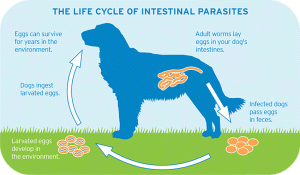Pet Holiday Hazards
The holidays are a festive time for us and our pets. However, due to ongoing activities and constant distractions, we can easily overlook potential dangers to our four-legged family members. Take preventive measures to protect your pets this holiday season by being aware of these holiday hazards and what dangers they can cause to our furry loved ones.
1. Food Hazards
Festive events often mean edible treats and lots of them! Unfortunately, some of the most popular holiday goodies, such as chocolate, bones and nuts, can be extremely toxic or fatal to pets. Chocolate, depending on the type and amount ingested can cause vomiting and diarrhea. Truly toxic amounts can induce hyperactivity, tremors, high blood pressure, a rapid heart rate, seizures, respiratory failure, and cardiac arrest. Dark chocolate and baker’s chocolate are the riskiest, while milk and white chocolate pose a much less serious risk. Fat Trimmings whether cooked or uncooked can cause pancreatitis. Bones, cooked or uncooked, can splinter and cause choking hazards, an obstruction or lacerations of your pet’s digestive system. Nuts like almonds, non-moldy walnuts, and pistachios cause upset stomach, and can obstruct their throat and/or their intestinal tract. Macadamia nuts and moldy walnuts are toxic and cause seizures and/or neurological issues. Lethargy, vomiting, and loss of muscle control are just some of the effects of nut ingestion in pets. Make sure to closely monitor your pet this holiday season and take precautions to ensure they have a safe and healthy holiday!
Christmas Trees- Be sure to securely anchor your Christmas tree so it doesn’t tip and fall, causing possible injury to your pet. This will also prevent the tree water, which may contain fertilizers that can cause stomach upset, from spilling. Stagnant tree water is a breeding ground for bacteria and your pet could end up with nausea or diarrhea should he drink the water. Tinsel-less Town- Tinsel is a very attractive, shiny, and dangling decoration. Kitties love this sparkly, light-catching “toy” that’s easy to bat around and carry in their mouths. But a nibble can lead to a swallow, which can lead to an obstructed digestive tract, severe vomiting, dehydration and possible surgery. Ornaments may be bright and colorful but they pose a real danger to your pets. Ornaments are a choking hazard so be sure to place all aluminum, paper, and glass ornaments high enough on your Christmas tree to where your pet cannot get to them. Glass ornaments pose a greater risk to your pet because if they were to chew and swallow the ornament, the broken pieces can then lacerate their mouth, throat, and intestines. Candles are dangerous because your pet can damage their paws by placing them over the candle’s flame. If your pet were to knock over one of your lit candles, the hot wax could cause severe burns to your pet’s feet- not to mention a fire hazard to your home. Keep your candles in a hard to reach area in order to deter your pets curiosity. Electrical Cords- Have a pet that likes to chew? Be sure to keep all electrical cords covered so your pets cannot get to them. Electric shock, tongue lacerations, and even death can occur if your pet bites down on an electrical cord.
They may be pretty, but some holiday plants are poisonous and even deadly. As little as a single leaf from any lily variety is lethal to cats. Pine needles can produce oral irritation, vomiting, diarrhea, and lethargy. Holly which is commonly found during the holiday season can cause intense vomiting, diarrhea, and depression. Mistletoe can cause significant vomiting and diarrhea, difficulty breathing, collapse, hallucinations, erratic behavior, and even death when ingested. Poinsettias can cause irritation to the mouth and stomach and sometime cause vomiting. For more on toxic plants, visit this toxic plant guide.
The Importance of Routine Intestinal Parasite Screenings
Why are intestinal parasites so harmful and why is it so important to prevent them in our pets? Parasites living in your pet’s gastrointestinal tract prevent your pet from digesting and absorbing nutrients properly, and cause serious illnesses, and even death. The most common symptoms of intestinal parasites may include: vomiting, diarrhea, weight loss, anemia, poor coat and a ravenous appetite. Keep in mind that these parasites can affect your pet’s health long before any symptoms appear. Roundworms, Hookworms, Tapeworms, Whipworms, Coccidia, and Giardia are the most common intestinal parasites found in cats and dogs. Some of these parasites are considered “zoonotic” which means that they can also infect humans; this is why it is so important to have your pet periodically screened for intestinal parasites. These preventative screenings can identify the specific intestinal parasite(s) your pet may have, which is important for determining the best method of treatment, and helping to ensure your pet a full recovery. Just because you aren’t visibly seeing any parasites passing in your pet’s stool doesn’t mean that they’re not there. Most of these parasites aren’t visible in your pet’s feces which is another reason your pet should be screened for these parasites at least 1-2 times a year for adult cats and dogs, and 2-4 times a year to keep your puppy or kitten completely protected for their first year of life.
How does my pet contract intestinal parasites? Intestinal parasites are transmitted from pet to pet by fleas, contaminated feces and soil, and young animals (puppies and kittens) are infected with them either in the womb or by their mother’s milk. Once initial deworming is completed, dogs and cats should be put on a monthly, year-round product that prevents intestinal parasites as well as heartworm infection.




